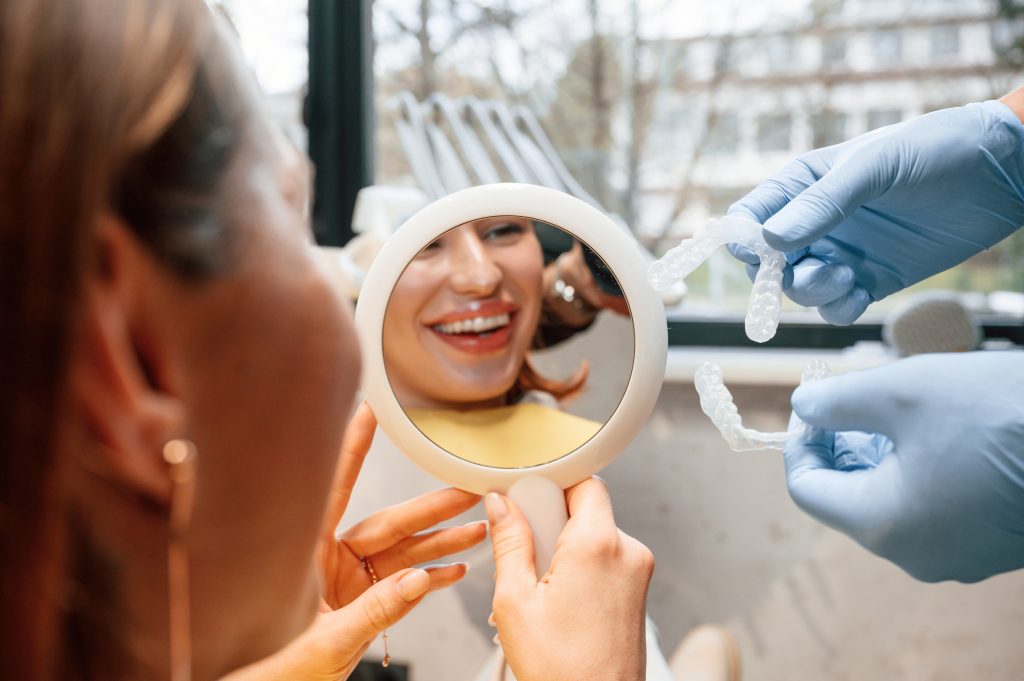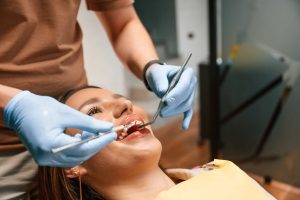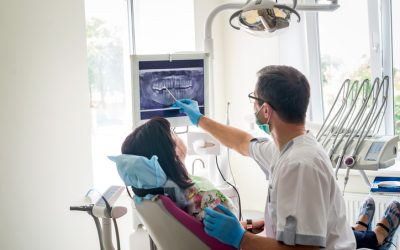July 19, 2024
Dr. Andres de Cardenas
All-on-4 dental implants, cosmetic bonding, Cosmetic Dental Care Services, cosmetic dentist Miami, Cosmetic Dentist Whitening, Cosmetic Dentistry, Daily Health Tips, dental care, Dental Care Tips, Dental Cleaning Appointment, Dental Implant Procedure, dental solutions, Dentist Appointment, family dental Care dentist, Family Dentist, FL, healthy teeth, Natural teeth whitening, Oral Cancer, Oral Care, professional denstists, Smile Makeover, Teeth Alignment, Teeth discoloration, Teeth Whitening, teeth whitening sensitive teeth, The Miami Cosmetic Dentist
Family Dental Care Miami | Miami Cosmetic Dentist > Blog > dental care > The Advantages Of Invisalign For Teeth Whitening
The Advantages Of Invisalign For Teeth Whitening
November 3, 2023
Dr. Andres de Cardenas
dental care, Dental Care Tips, Family Dentist, Invisalign, The Miami Cosmetic Dentist

A confident smile can significantly elevate your self-esteem, and having a set of beautiful, white, and well-aligned teeth plays a major role in that. Often, people with misaligned or discolored teeth seek treatment options to improve the appearance of their smile.
Invisalign, an innovative orthodontic treatment, is one solution that has gained immense popularity in recent times. With its clear aligners, Invisalign not only straightens your teeth but also paves the way for effective teeth whitening. In this blog article, we will introduce you to the world of Invisalign, its advantages, and how it can help you achieve the smile you’ve always wanted.
Gone are the days when traditional braces with bulky brackets and wires were the only option for orthodontic treatment. Today, Invisalign is a modern and comfortable alternative, allowing patients to achieve the desired teeth alignment without sacrificing aesthetics. Invisalign aligners, crafted with clear plastic, are virtually invisible and meticulously designed to fit your teeth. Their unnoticeable nature means you can undergo orthodontic treatment without drawing any unwanted attention.
The Invisalign treatment process involves using a series of custom-made, clear aligners tailored to your unique dentition. These aligners gradually move your teeth into an ideal position over time, resulting in a beautiful and functional smile. Another advantage of Invisalign over traditional metal braces is its convenience in their removable nature, making it easier to maintain oral hygiene, floss, and brush your teeth.
While Invisalign primarily focuses on straightening your teeth, the clear aligners’ removable feature makes it highly compatible with teeth whitening treatments. You can now achieve a brighter, straighter smile with a single treatment plan. In this article, we will delve into the advantages of combining teeth whitening with Invisalign to attain that picture-perfect smile.
 Overview Of Invisalign Installation
Overview Of Invisalign Installation
First impressions matter and your smile becomes your silent greeting. The pattern and alignment of your teeth play a huge role in shaping that smile, and if those aren’t picture-perfect, it can feel like a huge knock on your confidence.
But there’s a solution to consciously hiding your teeth or suppressing your laughter called Invisalign. To give you an idea of what Invisalign is, let’s dive into the revolutionary world of orthodontics, unraveling the materials used and the treatment process.
What Is Invisalign?
Invisalign is essentially a brand of clear aligners used to straighten teeth. These aligners are a transparent, plastic form of dental braces used to adjust misaligned teeth. Unlike metal braces that scream for attention, Invisalign works quietly behind the scenes, straightening your smile without anyone noticing.
The material that sets Invisalign apart from traditional braces is the sturdy yet flexible SmartTrack® plastic. Free from the likes of BPA, BPS, latex, or gluten, these FDA-approved clear aligners are custom-made for snug comfort. Because they’re virtually invisible, people are more likely to notice your gradually straightening teeth before they notice your Invisalign braces.
The Process — How Invisalign Works
So, how does this Invisalign treatment process work? Let’s break it down into simple steps:
- Initial Consultation: The entire Invisalign treatment process is designed with the end goal in mind – your perfect smile. Initially, during an examination, your dentist figures out whether Invisalign is the right choice for you. Then, imprints or scans of your teeth are taken to customize the Invisalign aligners according to your dental structure.
- Customized Treatment Plan: The clear aligners find their root in an advanced 3D computer imaging technology where your dentist or orthodontist prepares a tailored plan for your teeth, mapping out the sequence of steps your teeth will go through as they gradually align over time. Simply put, you’ll be able to see a preview of your smile transformation even before it starts.
- Wearing the Aligners: Once your aligners are ready, your journey to a spectacular smile begins. You’ll have to wear them diligently – about 20-22 hours daily. These clear aligners are swapped out approximately every one to two weeks, with each new set slowly moving your teeth toward the desired position. One of the key advantages of Invisalign treatment is that they’re removable. This means you can eat and drink without hindrance, maintaining your oral hygiene routine without wires or brackets getting in the way. Essentially, they simplify your life while being efficient in their job.
- Regular Check-ups: Your treatment plan also considers regular dental visits. Every 6 to 8 weeks, you’ll see your dentist, who will assess your progress and provide you with the next set of aligners in your sequence. Your treatment time will depend on your unique situation, but on average, it can range anywhere from 12 to 18 months.
- Post-treatment Maintenance: Following the treatment, retainers are usually used to maintain the new position of your teeth. The Vivera® Retainer, developed by the makers of Invisalign aligners, is custom-made using the same technology, ensuring a perfect fit to prevent relapse.
Invisalign has proven to be an excellent treatment option to straighten teeth, correct crowding or spacing issues, and mitigate problems like overbite or crossbite. But it doesn’t stop there. Invisalign also lends itself well to teeth whitening treatments. With the ability to remove your braces when necessary, you can apply teeth whitening solutions and simultaneously get straighter, brighter teeth.
Invisalign presents an innovative leap in the orthodontics world. Its design and technology navigate daily challenges posed by traditional braces, ensuring your life doesn’t skip a beat while your smile constantly improves.
 How Invisalign Aids In Teeth Whitening
How Invisalign Aids In Teeth Whitening
Invisalign clear aligners, an innovation over traditional metal braces, have been revolutionizing smiles and counting. However, have you considered it to simultaneously achieve a dual goal – straightening and whitening your teeth? This could make the cost of Invisalign a smart oral health investment.
Dual Purpose Of Invisalign
One might think of Invisalign as an intrinsic appliance for tooth movement, but its utility expands beyond that. The clear plastic used to make these aligners, unlike braces, provides an added advantage – an opportunity for teeth whitening.
As you wear Invisalign for 20-22 hours daily to straighten your teeth, why not also utilize this treatment for an enhanced, brighter smile? This dual-purpose not only optimizes the aligner cost but adds value to your oral health, making Invisalign a more lucrative choice over traditional braces or Invisalign-like treatment options.
However, although the Invisalign website shares comprehensive details, teeth whitening isn’t an automatic part of the treatment, it is essential to consult with your orthodontist or dentist before incorporating a whitening plan into your Invisalign regimen.
Invisalign With Whitening Gel
Invisalign aligners, a favorite type of orthodontic treatment, have the potential to serve as a base for applying whitening gel. As the aligners are made of clear plastic and designed to snugly fit on your teeth, they can hold the gel uniformly over your teeth.
Cleaning your teeth thoroughly, preferably with a brush and floss, before applying the gel will enhance the contact between the gel and your teeth. The gel spread inside your aligners, particularly targeting the front tooth area, once worn, will slowly move across your tooth surfaces, courtesy of your saliva. This will gradually start lightening the color of your teeth, giving you a brighter and new smile over time.
Remember to wear your Invisalign for at least 22 hours a day for promising results. With regular use, the confident smile starts appearing, providing a marked contrast to previous experience with metal braces or even invisible aligners.
Uniform Whitening With Invisalign
The Free Dictionary by the American Association of Orthodontists acknowledges uniform tooth whitening as one of the frequently faced challenges in oral aesthetics. However, the clear plastic features of the Invisalign aligners aid in applying the whitening gel uniformly. They ensure a deep and wholesome spread of the whitening solution on the tooth surfaces, promising consistent results.
A distinguishing USP for Invisalign is its simulation technology. The 3D scan of your teeth assists in manufacturing an accurate set of aligners that neatly map the layout of your mouth. Consequently, the distribution of the whitening gel over your teeth becomes homogeneous, ensuring a balanced teeth-whitening effect.
Clearly, Invisalign patients not only get straighter teeth but also uniformly whiter smiles. However, this requires approval and guidance from your Invisalign-trained orthodontist or dentist, tying your tooth straightening plan with a teeth-whitening goal.
To encapsulate, considering Invisalign means investing in your smile, which involves not only straighter teeth but also a brighter smile. Insurance plans and payment plans all need to be determined by your doctor after a detailed discussion about your treatment.
Moreover, you want to straighten your teeth without the discomfort of metal brackets and wires. This improved individualized oral healthcare plan provides foolproof coverage for your dental aspirations, be it invisible braces or lingual braces.
If a desire to have uniformly whitened teeth coincides with your orthodontic treatment, then Invisalign might be your solution. This multi-feature treatment accessible near you today is indeed the future of orthodontics. After all, everyone deserves a new and confident smile!
 Additional Advantages Of Invisalign Over Traditional Braces
Additional Advantages Of Invisalign Over Traditional Braces
When it comes to orthodontic treatment, Invisalign clear aligners have turned the tables, providing an impressive array of advantages over traditional braces. Their innovative design and functionality offer comfort, convenience, improved self-confidence, and enhanced oral health. Eager to learn more?
Comfort Over Traditional Braces
First on the docket is comfort, where Invisalign takes a compelling lead against traditional braces or retainers. A journey to straighter teeth doesn’t have to be dichotomized with discomfort or unpleasant experiences. With Invisalign aligners, get ready to embrace a treatment that doesn’t entail wires, brackets, or discomfort in your mouth. Crafted from flexible and clear plastic, these aligners sit comfortably against your teeth, unlike their traditional metal counterparts.
Invisalign works by gently moving your teeth in a virtually painless way. Its cutting-edge alignment technology maps out a detailed treatment plan, gradually straightening your teeth precisely. No more tightening sessions, painful soreness, or consequences of a bracket popping free! This makes Invisalign not just a treatment option but a lifestyle choice that integrates effortlessly with your day-to-day life.
Convenience Of Using Invisalign
As modern orthodontics pledge convenience, Invisalign takes the crown. Unlike braces, which demand exceptional commitment and adjustment, Invisalign aligners are designed to match your pace. Enjoy the liberty to remove the aligners as you feast on your favorite meals or to maintain dental hygiene with a regular brush and floss – all without the complication of navigating wires or elastics.
The treatment time with Invisalign often tends to be shorter than traditional metal braces, making your journey to a perfect smile faster. Moreover, with dentists having access to progressive align technology by Invisalign, it’s easy to streamline predictable treatment plans, monitor progress, and provide timely interventions, all wrapped in convenience you never thought existed in orthodontic treatment.
Invisalign aligners are clear, near-invisible, and subtler than crowd-clear braces, providing a distinct advantage – a significant confidence boost.
Improved Oral Health With Invisalign
Last but not least, Invisalign aligners contribute to improved oral health.
Since the aligners are removable, brushing and flossing can be done as usual, enabling thorough cleaning of your teeth and gums. Apart from personal care, under a dentist’s recommendation, Invisalign treatment can fix complex dental issues that can indirectly endanger oral health, like fixing an overbite, closing spaces due to spacing issues, or realigning crowded teeth.
Your dental insurance may even cover part of these costs, making Invisalign a cost-effective and health-efficient orthodontic solution. With the accessibility to remove the teeth aligners, you can keep your periodontal health in check even during the treatment, reducing risks like cavities or gum diseases.
In conclusion, the advantages of Invisalign extend beyond merely aligning teeth; they deliver optimal comfort, offer tremendous convenience, boost self-esteem, and ultimately contribute to improved oral health. Under the guidance of trained orthodontists, Invisalign changed the notion of orthodontic treatment from a daunting challenge to a rewarding journey. Exceptional flexibility, easy maintenance, and enhanced aesthetics – Invisalign provides everything, setting you on a seamless road to a picture-perfect smile. Considering all these benefits, it’s no surprise that Invisalign is fast becoming the preferred option for teeth straightening globally, making ‘Invisalign’ the keyword in modern-day orthodontics.
 Cost And Availability Of Invisalign
Cost And Availability Of Invisalign
Navigating the world of orthodontics can be overwhelming. Among various treatment options, Invisalign stands out with its cutting-edge and discreet approach to teeth straightening. As you consider investing in a better smile, it’s important to understand the costs involved and the availability of Invisalign treatment.
The Cost Of Invisalign
The cost of Invisalign treatment is highly influenced by various factors, including:
- Geographical location: Prices might differ depending on where you live, with certain metropolitan areas boasting higher living costs and, subsequently, higher treatment prices.
- Dentist or Orthodontist expertise: Professionals with a higher level of competency and experience may charge more for their services.
- The complexity of the case: The severity of your orthodontic issues dictates the treatment time and resources required, which can influence overall costs.
Though prices may vary, Invisalign often falls within the same price range as traditional braces. The average cost for Invisalign treatment in the United States, for instance, ranges from $3,000 to $7,000.
To obtain a detailed estimate unique to your case, consult a local Invisalign-trained orthodontist or a dentist like those at Andre de Cardenas, DMD.
Insurance Coverage
Many dental insurance plans include orthodontic coverage, which might partially cover the cost of Invisalign treatment. Check your insurance policy to determine what orthodontic-related expenses are eligible for reimbursement.
You can also contact your insurance provider for clarification regarding coverages and limits. It’s worth noting that Invisalign is often treated as a standard orthodontic procedure and, therefore, may be covered at a similar rate as traditional braces under most insurance plans.
Payment Plans
Several orthodontists and dentists offer payment plans that help spread the cost of Invisalign treatment over a more extended period. These plans may be in-house or facilitated through third-party financing companies, often providing low-interest or interest-free payment programs. Inquire with your dental professional about available financing options, and choose a payment plan that matches your financial situation and budget.
Keep in mind that while the cost of Invisalign treatment may initially appear daunting, make sure to take into account the long-term benefits gained from this investment in your appearance, oral health, and self-esteem. Also, remember to consider the potential costs of alternative treatment options, such as the inconvenience, discomfort, and possibly frequent repairs of traditional metal braces.
When you have a clear understanding of the cost of Invisalign treatment, aligning your teeth becomes a more viable endeavor. By researching dental insurance support and payment plans and consulting with your local Invisalign-trained professionals, you’ll be better equipped to make an informed decision on whether Invisalign is the best choice for you or your loved ones. With the right support and guidance, your path toward a straighter, more confident smile is within reach.
FAQs About Invisalign
Invisalign clear aligners transform the orthodontic landscape, providing a visually seamless and non-invasive alternative to traditional metal braces. Naturally, you may have questions and concerns about this advanced clear aligner system. Let us address common queries, misconceptions, and professional advice regarding Invisalign.
1. What are the most common issues Invisalign can treat?
Invisalign aligners can treat various orthodontic problems, including:
- Crowded teeth
- Overbite
- Underbite
- Crossbite
- Gap teeth
- Open bite
Your Invisalign-trained orthodontist or dentist will determine the best course of action for your case to provide the best results.
2. How does Invisalign work?
Invisalign aligners, made of clear plastic, apply gentle pressure to push your teeth ever so slightly in the desired direction. Your doctor will create a customized treatment plan involving a series of aligners, with each set gradually straightening your teeth. You’ll typically switch to the next set of aligners every one to two weeks.
3. How long does Invisalign take?
The duration of Invisalign treatment varies depending on the patient’s individual case; however, the average treatment time ranges from 12 to 18 months. It’s essential to wear your aligners for 20-22 hours a day, as recommended by the American Association of Orthodontists, to ensure effective and timely results.
4. How much does Invisalign cost?
The cost of Invisalign varies depending on location, doctor’s expertise, and case complexity. In general, the cost falls within a similar range as other orthodontic treatments, such as traditional braces. To determine the specific cost, seek an estimate from a local Invisalign-trained professional. Many dental insurance plans cover Invisalign costs, and you could explore payment plans to accommodate your budget.
5. How often should I wear and replace my aligners?
Wear your Invisalign aligners for 20-22 hours a day, removing them only for eating, drinking (anything other than water), brushing, and flossing. Replace your aligners according to your doctor’s guidance, typically every 1-2 weeks or as your teeth progress through each stage of movement.
6. How do you maintain and clean Invisalign aligners?
Keep your aligners clean by removing them before meals and brushing them gently with a soft toothbrush and lukewarm water—avoid using colored or scented soaps as they might leave residue or affect the aligner’s clarity. For optimal oral health, brush and floss your teeth before reinserting the aligners.
7. Can I benefit from Invisalign even if I previously had braces or other dental work?
Yes, patients who have had braces or other dental work in the past can still benefit from Invisalign treatment. Consult your doctor to discuss the suitability of Invisalign based on your specific situation.
8. Are there any food restrictions with Invisalign?
Unlike traditional braces, Invisalign doesn’t impose food restrictions. Simply remove your aligners before eating or drinking, rinse them, and put them back after you’ve finished and brushed your teeth.
9. Is there an age limit for Invisalign?
Invisalign is suitable for both teenagers and adults. Though each case varies, Invisalign can be used to treat baby and permanent teeth and even fairly complicated issues when deemed appropriate by a professional.
Choosing Invisalign means making a big investment in your oral health and confidence. With Invisalign clear aligners, a bright and straighter smile is within reach. Armed with these crucial answers and advice, you’ll be better prepared to make an informed decision to improve your smile, one aligner at a time.
Invisalign is truly a game-changer in the world of orthodontics, providing a discreet and effective route to straighten your teeth. This clear aligner system not only addresses orthodontic concerns but also opens the door for more effective teeth whitening. The dual benefits of Invisalign – enhanced aesthetics and better oral health, can greatly boost your confidence. However, remember that personal situations vary: consult an Invisalign-trained dentist or orthodontist like those at Andre de Cardenas, DMD, for a tailored treatment plan that suits your unique needs. Now, it’s time to embrace the journey to a healthier, brighter smile with Invisalign.
Get the Smile you Deserve!
Seek out the best cosmetic dentist, Dr. Andres de Cardenas, and call us today!
Call Dr. Andres de Cardenas today at 305-251-3334!
Cosmetic dentistry offers many options for people who are unhappy with the appearance of their smile. If you’re one of these people, we encourage you to seek out the veneers, cosmetic dentistry in Miami.
Get In Touch With Us
Recent Posts
- Bright Smiles, Brighter Futures: Why Cosmetic Dentist Whitening Is Worth It
- Safeguard Your Smile: Family Dental Care Dentist Debunks DIY Dentistry Tips!
- Dental Implant FAQs: What to Know About the Recovery Process
- The Health Benefits Of Cosmetic Dental Care Services: Beyond Vanity
- The Ultimate Cosmetic Dental Checklist For Miami, FL Residents
Related articles
July 5, 2024
Dr. Andres de Cardenas
All-on-4 dental implants, cosmetic bonding, Cosmetic Dental Care Services, cosmetic dentist Miami, Cosmetic Dentistry, Daily Health Tips, dental care, Dental Care Tips, Dental Cleaning Appointment, Dental Implant Procedure, dental implant recovery, dental implants, dental solutions, Dentist Appointment, family dental Care dentist, Family Dentist, FL, healthy teeth, Oral Cancer, Oral Care, professional denstists, Smile Makeover, Teeth Alignment, Teeth discoloration, Teeth Whitening, The Miami Cosmetic Dentist
Safeguard Your Smile: Family Dental Care Dentist Debunks DIY Dentistry Tips!
June 21, 2024
Dr. Andres de Cardenas
All-on-4 dental implants, cosmetic bonding, Cosmetic Dental Care Services, cosmetic dentist Miami, Cosmetic Dentistry, Daily Health Tips, dental care, Dental Care Tips, Dental Cleaning Appointment, Dental Implant Procedure, dental implant recovery, dental implants, dental solutions, Dentist Appointment, Family Dentist, FL, healthy teeth, Oral Cancer, Oral Care, professional denstists, Smile Makeover, Teeth Alignment, Teeth discoloration, Teeth Whitening, The Miami Cosmetic Dentist


